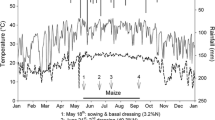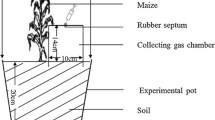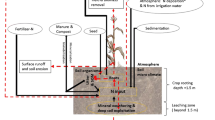Abstract
Aims: To assess how biochar addition in rainfed conservation agriculture affects short-term transformation, plant uptake, retention of nitrogen (N) in soil, and nitrous oxide (N2O) fluxes in a tropical Arenosol planted to maize. Methods: A ten-day in situ 15N pool dilution and N cycling experiment, using tracer amounts (0.1 g m-2) of 15N labeled ammonium (15NH4+), nitrate (15NO3-) or 15N-urea, was carried out seven weeks after planting of maize (Zea mays L.) under conservation agriculture in Zambia, using planting basins without (CA) and with pigeon-pea biochar (BC) addition (4 t ha-1). Results: Pigeon-pea biochar increased soil NO3- concentration, gross nitrification rate, 15N recovery in extractable soil NO3-, and soil moisture. However, effects of biochar on soil N retention and plant N uptake were not significant. Likewise, biochar did not affect N2O fluxes. Conclusions: At low dosage, pigeon pea biochar has a positive effect on gross nitrification rate but does not affect short-term N retention in soil, N2O fluxes, nor does it help increasing the uptake of N by maize.






Similar content being viewed by others
References
Abiven S, Hund A, Martinsen V, Cornelissen G (2015) Biochar amendment increases maize root surface areas and branching: a shovelomics study in Zambia. Plant and Soil 395:45–55. https://doi.org/10.1007/s11104-015-2533-2
Angst TE, Patterson CJ, Reay DS, Anderson P, Peshkur TA, Sohi SP (2013) Biochar diminishes nitrous oxide and nitrate leaching from diverse nutrient sources. J Environ Qual 42:672–682. https://doi.org/10.2134/jeq2012.0341
Berglund LM, DeLuca TH, Zackrisson O (2004) Activated carbon amendments to soil alters nitrification rates in Scots pine forests. Soil Biology and Biochemistry 36:2067–2073. https://doi.org/10.1016/j.soilbio.2004.06.005
Biederman LA, Harpole WS (2013) Biochar and its effects on plant productivity and nutrient cycling: a meta-analysis. GCB Bioenergy 5:202–214. https://doi.org/10.1111/gcbb.12037
Borchard N, Schirrmann M, Cayuela ML, Kammann C, Wrage-Monnig N, Estavillo JM, Fuertes-Mendizabal T, Sigua G, Spokas K, Ippolito JA, Novak J (2019) Biochar, soil and land-use interactions that reduce nitrate leaching and N2O emissions: A meta-analysis. Sci Total Environ 651:2354–2364. https://doi.org/10.1016/j.scitotenv.2018.10.060
Buchen C, Well R, Helfrich M, Fuß R, Kayser M, Gensior A, Benke M, Flessa H (2017) Soil mineral N dynamics and N 2 O emissions following grassland renewal. Agriculture, Ecosystems & Environment 246:325–342. https://doi.org/10.1016/j.agee.2017.06.013
Budai A, Wang L, Gronli M, Strand LT, Antal MJ Jr, Abiven S, Dieguez-Alonso A, Anca-Couce A, Rasse DP (2014) Surface properties and chemical composition of corncob and miscanthus biochars: effects of production temperature and method. J Agric Food Chem 62:3791–3799. https://doi.org/10.1021/jf501139f
Case SDC, McNamara NP, Reay DS, Stott AW, Grant HK, Whitaker J (2015) Biochar suppresses N2O emissions while maintaining N availability in a sandy loam soil. Soil Biology and Biochemistry 81:178–185. https://doi.org/10.1016/j.soilbio.2014.11.012
Cayuela ML, Jeffery S, van Zwieten L (2015) The molar H:Corg ratio of biochar is a key factor in mitigating N2O emissions from soil. Agriculture, Ecosystems & Environment 202:135–138. https://doi.org/10.1016/j.agee.2014.12.015
Cayuela ML, Sánchez-Monedero MA, Roig A, Hanley K, Enders A, Lehmann J (2013) Biochar and denitrification in soils: when, how much and why does biochar reduce N2O emissions? Scientific Reports 3:1732. https://doi.org/10.1038/srep01732
Cayuela ML, van Zwieten L, Singh BP, Jeffery S, Roig A, Sánchez-Monedero MA (2014) Biochar's role in mitigating soil nitrous oxide emissions: A review and meta-analysis. Agriculture, Ecosystems & Environment 191:5–16. https://doi.org/10.1016/j.agee.2013.10.009
CFU (2011) The Practice of Conventional and Conservation Agriculture in East and Southern Africa
Clough T, Condron L, Kammann C, Müller C (2013) A Review of Biochar and Soil Nitrogen Dynamics. Agronomy 3:275–293. https://doi.org/10.3390/agronomy3020275
Cornelissen G, Jubaedah NNL, Hale SE, Martinsen V, Silvani L, Mulder J (2018) Fading positive effect of biochar on crop yield and soil acidity during five growth seasons in an Indonesian Ultisol. Sci Total Environ 634:561–568. https://doi.org/10.1016/j.scitotenv.2018.03.380
Cornelissen G, Martinsen V, Shitumbanuma V, Alling V, Breedveld G, Rutherford D, Sparrevik M, Hale S, Obia A, Mulder J (2013) Biochar Effect on Maize Yield and Soil Characteristics in Five Conservation Farming Sites in Zambia. Agronomy 3:256–274. https://doi.org/10.3390/agronomy3020256
Cornelissen G, Pandit NR, Taylor P, Pandit BH, Sparrevik M, Schmidt HP (2016) Emissions and Char Quality of Flame-Curtain "Kon Tiki" Kilns for Farmer-Scale Charcoal/Biochar Production. PLoS One 11:e0154617. https://doi.org/10.1371/journal.pone.0154617
Davidson EA, Hart SC, Shanks CA, Firestone MK (1991) Measuring gross nitrogen mineralization, immobilization, and nitrification by 15N isotopic pool dilution in intact soil cores. J Soil Sci 42:335–349
Ding Y, Liu Y-X, Wu W-X, Shi D-Z, Yang M, Zhong Z-K (2010) Evaluation of Biochar Effects on Nitrogen Retention and Leaching in Multi-Layered Soil Columns. Water, Air, & Soil Pollution 213:47–55. https://doi.org/10.1007/s11270-010-0366-4
Engel ER, Romero MC, Patrickcarr, A. Torrion J, Annenaeth M (2019) Performance of nitrate compared with urea fertilizer in a semiarid climate of the northern Great Plains. 99: 345-355. doi: 10.1139/cjss-2019-0047.
Edmonds DE, Abreu SL, West A, Caasi DR, Conley TO, Daft MC, Desta B, England BB, Farris CD, Nobles TJ, Patel NK, Rounds EW, Sanders BH, Shawaqfeh SS, Lakmini L, Manandhar R, Raun WR (2009) Cereal Nitrogen Use Efficiency in Sub Saharan Africa. Journal of Plant Nutrition 32:2107–2122. https://doi.org/10.1080/01904160903308184
Hale SE, Alling V, Martinsen V, Mulder J, Breedveld GD, Cornelissen G (2013) The sorption and desorption of phosphate-P, ammonium-N and nitrate-N in cacao shell and corn cob biochars. Chemosphere 91:1612–1619. https://doi.org/10.1016/j.chemosphere.2012.12.057
Hink L, Lycus P, Gubry-Rangin C, Frostegard A, Nicol GW, Prosser JI, Bakken LR (2017) Kinetics of NH3 -oxidation, NO-turnover, N2 O-production and electron flow during oxygen depletion in model bacterial and archaeal ammonia oxidisers. Environ Microbiol 19:4882–4896. https://doi.org/10.1111/1462-2920.13914
Jeffery S, Abalos D, Prodana M, Bastos AC, van Groenigen JW, Hungate BA, Verheijen F (2017) Biochar boosts tropical but not temperate crop yields. Environmental Research Letters 12:053001. https://doi.org/10.1088/1748-9326/aa67bd
Jeffery S, Meinders MBJ, Stoof CR, Bezemer TM, van de Voorde TFJ, Mommer L, van Groenigen JW (2015) Biochar application does not improve the soil hydrological function of a sandy soil. Geoderma 251-252:47–54. https://doi.org/10.1016/j.geoderma.2015.03.022
Kätterer T, Roobroeck D, Andrén O, Kimutai G, Karltun E, Kirchmann H, Nyberg G, Vanlauwe B, Röing de Nowina K (2019) Biochar addition persistently increased soil fertility and yields in maize-soybean rotations over 10 years in sub-humid regions of Kenya. Field Crops Research 235:18–26. https://doi.org/10.1016/j.fcr.2019.02.015
Kim DG, Thomas AD, Pelster D, Rosenstock TS, Sanz-Cobena A (2016) Greenhouse gas emissions from natural ecosystems and agricultural lands in sub-Saharan Africa: synthesis of available data and suggestions for further research. Biogeosciences 13:4789–4809. https://doi.org/10.5194/bg-13-4789-2016
Kirkham D, Bartholomew WV (1954) Equations for Following Nutrient Transformations in Soil. Utilizing Tracer Data Soil Sci Soc Am Proc 18:33–34
Krogstad T, Øgaard AF, Kristoffersen AØ (2008) New P recommendations for grass and cereals in Norwegian agriculture. NJF Seminar:42–46
Kuznetsova A, Brockhoff PB, Christensen RHB (2017) lmerTest Package: Tests in Linear Mixed Effects Models. Journal of Statistical Software 82. doi: https://doi.org/10.18637/jss.v082.i13.
Lancashire PD, Bleiholder H, van den Boom T, Langelüddecke P, Stauss T, Weber E, Witzenberger A (1991) An uniform decimal code for growth stages of crops and weeds. Ann appl Biol 119:561–601
Libanda B, Zheng M, Ngonga C (2019) Spatial and temporal patterns of drought in Zambia. Journal of Arid Land 11:180–191. https://doi.org/10.1007/s40333-019-0053-2
Liu Q, Zhang Y, Liu B, Amonette JE, Lin Z, Liu G, Ambus P, Xie Z (2018) How does biochar influence soil N cycle? A meta-analysis. Plant and Soil 426:211–225. https://doi.org/10.1007/s11104-018-3619-4
Major J, Rondon M, Molina D, Riha SJ, Lehmann J (2012) Nutrient leaching in a Colombian savanna Oxisol amended with biochar. J Environ Qual 41:1076–1086. https://doi.org/10.2134/jeq2011.0128
Martinsen V, Alling V, Nurida NL, Mulder J, Hale SE, Ritz C, Rutherford DW, Heikens A, Breedveld GD, Cornelissen G (2015) pH effects of the addition of three biochars to acidic Indonesian mineral soils. Soil Science and Plant Nutrition 61:821–834. https://doi.org/10.1080/00380768.2015.1052985
Martinsen V, Mulder J, Shitumbanuma V, Sparrevik M, Børresen T, Cornelissen G (2014) Farmer-led maize biochar trials: Effect on crop yield and soil nutrients under conservation farming. Journal of Plant Nutrition and Soil Science 177:681–695. https://doi.org/10.1002/jpln.201300590
Mérigout P, Gaudon V, Quilleré I, Briand X, Daniel-Vedele F (2008) Urea Use Efficiency of Hydroponically Grown Maize and Wheat. Journal of Plant Nutrition 31:427–443. https://doi.org/10.1080/01904160801894970
Munera-Echeverri JL, Martinsen V, Strand LT, Cornelissen G, Mulder J (2020) Effect of conservation farming and biochar addition on soil organic carbon quality, nitrogen mineralization, and crop productivity in a light textured Acrisol in the sub-humid tropics. PLoS One 15:e0228717. https://doi.org/10.1371/journal.pone.0228717
Munera-Echeverri JL, Martinsen V, Strand LT, Zivanovic V, Cornelissen G, Mulder J (2018) Cation exchange capacity of biochar: An urgent method modification. Sci Total Environ 642:190–197. https://doi.org/10.1016/j.scitotenv.2018.06.017
Musonda B, Jing Y, Iyakaremye V, Ojara M (2020) Analysis of Long-Term Variations of Drought Characteristics Using Standardized Precipitation Index over Zambia. Atmosphere:11. https://doi.org/10.3390/atmos11121268
Nelissen V, Rütting T, Huygens D, Staelens J, Ruysschaert G, Boeckx P (2012) Maize biochars accelerate short-term soil nitrogen dynamics in a loamy sand soil. Soil Biology and Biochemistry 55:20–27. https://doi.org/10.1016/j.soilbio.2012.05.019
Nguyen TTN, Xu C-Y, Tahmasbian I, Che R, Xu Z, Zhou X, Wallace HM, Bai SH (2017) Effects of biochar on soil available inorganic nitrogen: A review and meta-analysis. Geoderma 288:79–96. https://doi.org/10.1016/j.geoderma.2016.11.004
Nyamangara J, Bergström LF, Piha MI, Giller KE (2003) Fertilizer Use Efficiency and Nitrate Leaching in a Tropical Sandy Soil. Journal of Environment Quality 32. https://doi.org/10.2134/jeq2003.5990
Obia A, Børresen T, Martinsen V, Cornelissen G, Mulder J (2017) Vertical and lateral transport of biochar in light-textured tropical soils. Soil and Tillage Research 165:34–40. https://doi.org/10.1016/j.still.2016.07.016
Obia A, Cornelissen G, Martinsen V, Smebye AB, Mulder J (2020) Conservation tillage and biochar improve soil water content and moderate soil temperature in a tropical Acrisol. Soil and Tillage Research 197. https://doi.org/10.1016/j.still.2019.104521
Obia A, Cornelissen G, Mulder J, Dorsch P (2015) Effect of Soil pH Increase by Biochar on NO, N2O and N2 Production during Denitrification in Acid Soils. PLoS One 10:e0138781. https://doi.org/10.1371/journal.pone.0138781
Obia A, Mulder J, Martinsen V, Cornelissen G, Børresen T (2016) In situ effects of biochar on aggregation, water retention and porosity in light-textured tropical soils. Soil and Tillage Research 155:35–44. https://doi.org/10.1016/j.still.2015.08.002
Prommer J, Wanek W, Hofhansl F, Trojan D, Offre P, Urich T, Schleper C, Sassmann S, Kitzler B, Soja G, Hood-Nowotny RC (2014) Biochar Decelerates Soil Organic Nitrogen Cycling but Stimulates Soil Nitrification in a Temperate Arable Field Trial. PLOS ONE 9:e86388. https://doi.org/10.1371/journal.pone.0086388
Prosser JI, Nicol GW (2012) Archaeal and bacterial ammonia-oxidisers in soil: the quest for niche specialisation and differentiation. Trends in Microbiology 20:523–531. https://doi.org/10.1016/j.tim.2012.08.001
Providoli I, Bugmann H, Siegwolf R, Buchmann N, Schleppi P (2005) Flow of Deposited Inorganic N in Two Gleysol-dominated Mountain Catchments Traced with 15NO3− and 15NH4+. Biogeochemistry 76:453–475. https://doi.org/10.1007/s10533-005-8124-1
R-Core-Team (2020) R: A Language and Environment for Statistical Computing Version 3.4.3. R Foundation for Statistical Computing, Vienna, Austria.
Raji SG, Dörsch P (2020) Effect of legume intercropping on N<sub>2</sub>O emissions and CH<sub>4</sub> uptake during maize production in the Great Rift Valley, Ethiopia. Biogeosciences 17: 345-359. doi: https://doi.org/10.5194/bg-17-345-2020.
Rochette P, Angers DA, Chantigny MH, Gasser M-O, MacDonald JD, Pelster DE, Bertrand N (2013) NH3 volatilization, soil concentration and soil pH following subsurface banding of urea at increasing rates. Canadian Journal of Soil Science 93:261–268. https://doi.org/10.4141/cjss2012-095
Rosenstock TS, Mpanda M, Pelster DE, Butterbach-Bahl K, Rufino MC, Thiong’o M, Mutuo PK, Abwanda S, Rioux J, Kimaro AA, Neufeldt H (2016) Greenhouse gas fluxes from agricultural soils of Kenya and Tanzania. J Geophys Res Biogeosci 121:1568–1580. https://doi.org/10.1002/2016JG003341
Rütting T, Cizungu Ntaboba L, Roobroeck D, Bauters M, Huygens D, Boeckx P (2015) Leaky nitrogen cycle in pristine African montane rainforest soil. Global Biogeochemical Cycles 29:1754–1762. https://doi.org/10.1002/2015gb005144
Sánchez-García M, Roig A, Sánchez-Monedero MA, Cayuela ML (2014) Biochar increases soil N2O emissions produced by nitrification-mediated pathways. 2. doi: https://doi.org/10.3389/fenvs.2014.00025.
Schollenberger CJ (1945) Determination of exchange capacity and exchangeable bases in soil-Ammonium acetate method. Soil Sci 59:13–24
Shi W, Ju Y, Bian R, Li L, Joseph S, Mitchell DRG, Munroe P, Taherymoosavi S, Pan G (2020) Biochar bound urea boosts plant growth and reduces nitrogen leaching. Sci Total Environ 701:134424. https://doi.org/10.1016/j.scitotenv.2019.134424
Stevens RJ, Laughlin RJ (1994) Determining Nitrogen-15 in Nitrite or Nitrate by Producing Nitrous Oxide. Soil Sci Soc Am J 58:1108–1116
Thierfelder C, Chivenge P, Mupangwa W, Rosenstock TS, Lamanna C, Eyre JX (2017) How climate-smart is conservation agriculture (CA)? – its potential to deliver on adaptation, mitigation and productivity on smallholder farms in southern Africa. Food Security 9:537–560. https://doi.org/10.1007/s12571-017-0665-3
Thierfelder C, Matemba-Mutasa R, Rusinamhodzi L (2015) Yield response of maize (Zea mays L.) to conservation agriculture cropping system in Southern Africa. Soil and Tillage Research 146:230–242. https://doi.org/10.1016/j.still.2014.10.015
Thierfelder C, Wall PC (2009) Effects of conservation agriculture techniques on infiltration and soil water content in Zambia and Zimbabwe. Soil and Tillage Research 105:217–227. https://doi.org/10.1016/j.still.2009.07.007
Tzanakakis VA, Taylor AE, Bakken LR, Bottomley PJ, Myrold DD, Dörsch P (2019) Relative activity of ammonia oxidizing archaea and bacteria determine nitrification-dependent N2O emissions in Oregon forest soils. Soil Biology and Biochemistry 139. https://doi.org/10.1016/j.soilbio.2019.107612
van der Kruijs ACBM, Wong MTF, Juo ASR, Wild A (1988) Recovery of 15N-labelled fertilizer in crops, drainage water and soil using monolith lysimeters in south-east Nigeria. Journal of Soil Science 39:483–492
Weldon S, Rasse DP, Budai A, Tomic O, Dörsch P (2019) The effect of a biochar temperature series on denitrification: which biochar properties matter? Soil Biology and Biochemistry 135:173–183. https://doi.org/10.1016/j.soilbio.2019.04.018
WRB IWG (2015) World reference base for soil resources 2014, update 2015. International soil classification system for naming soils and creating legends for soil maps. World Soil Resources Reports No 106. FAO, Rome.
Yu L, Kang R, Mulder J, Zhu J, Dörsch P (2017) Distinct fates of atmogenic NH4+ and NO3− in subtropical, N-saturated forest soils. Biogeochemistry 133:279–294. https://doi.org/10.1007/s10533-017-0332-y
Zhu J, Yu L, Bakken LR, Morkved PT, Mulder J, Dorsch P (2018) Controlled induction of denitrification in Pseudomonas aureofaciens: A simplified denitrifier method for dual isotope analysis in NO3(). Sci Total Environ 633:1370–1378. https://doi.org/10.1016/j.scitotenv.2018.03.236
Acknowledgements
We are thankful to Dr. Victor Shitumbanuma and Edward Bwalya of the Soil Science Department of University of Zambia and to Mwenya Silombe and Phillip Maskbo for their support during the field experiment. We are thankful to Martin Muti Mafomafo, the farmer who made his farm available for the experiment, and to Matthews Chewe from the Conservation Farming Unit (CFU) in Zambia for his assistance in the field.
Availability of data and material
The data has been included as electronic supplementary material.
Code availability
Not applicable
Funding
The study was funded by NMBU PhD (15/02524-1750092003) internal financing to the first author and by the Faculty of Environmental Sciences and Nature Resource Management at NMBU as part of the stipend to Vegard Martinsen granted for young talented scientists. Peter Dörsch received funding from the FACCE-ERA-GAS project MAGGE-pH under the Grant Agreement No. 696356.
Author information
Authors and Affiliations
Corresponding author
Ethics declarations
Conflicts of interest/Competing interests
The authors declare no conflicts of interest
Additional information
Responsible Editor: Simon Jeffery.
Publisher’s note
Springer Nature remains neutral with regard to jurisdictional claims in published maps and institutional affiliations.
Rights and permissions
About this article
Cite this article
Munera-Echeverri, J.L., Martinsen, V., Dörsch, P. et al. Pigeon pea biochar addition in tropical Arenosol under maize increases gross nitrification rate without an effect on nitrous oxide emission. Plant Soil 474, 195–212 (2022). https://doi.org/10.1007/s11104-022-05325-4
Received:
Accepted:
Published:
Issue Date:
DOI: https://doi.org/10.1007/s11104-022-05325-4




